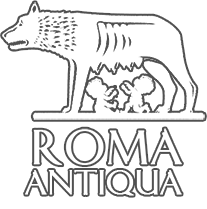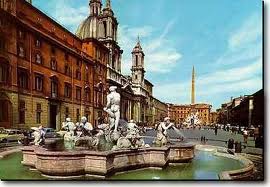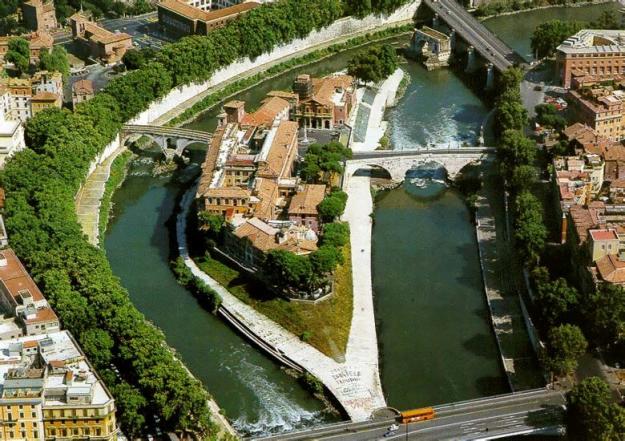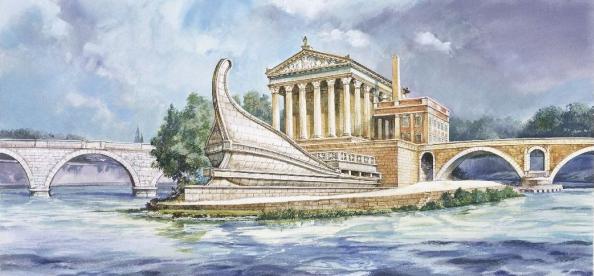Roma antica foro romano colosseo altare della patria circo massimo roma virtuale 3d lazio
roma-medievale-eng
inglese



The Middle Ages
The Middle Ages is undoubtedly one of the less emblematic periods of the Roman architecture, but very important. If you walk along the streets in the quarters of Trastevere or of the Jewish Ghetto, Vicolo dell’Atleta and Arco degli Acetari, real medieval views. But the greatest evidence appears in the works of the museums and churches. For the lovers of mosaics or medieval cloisters, the list is very long !!. Mausoleum of Saint Constance, Saint Agnes, Saints Cosmas and Damian,Saint Sabina, or the trio of Saint Mary Major, Saint Pudenziana and Saint Praxedes. Among the most important works of this period we can mention the following:

The Basilica was built in the IX century on the foundations, of Saint Caecilia’s house. It was later developed with the tower bell, the right side and the cloister.
In front of the Church with baroque façade, there is a colonnade of the XVIII century, the original colonnade is today a beautiful garden with a great Roman pot in the middle.
But in the basement of the church the "calidarium", that is the place where the martyr (S. Caecilia), had suffered for three years the torture, and where her persecutors beheaded her, not stifled by the hot fumes yet, on wish of emperor Marcus Aurelius, after the third day, because she was guilty, of having tried to convert Valeriano and his brother Tiburzio.
The body of the saint had been found for much time, it was brought to light in 820 in the catacombs of Saint Callixtus, miraculously uninjured and wrapped in a dress. Today the body is situated in the crypt of the basilica.
Piazza Navona
 History of Piazza Navona dates back to the times of ancient Rome. It is built on the site of the Stadium of Domitian, built in I century AD, once dedicated to public entertainment, games, and simulation of naval battles Piazza Navona has remained a place of amusement even after its decay. It was a place where people used to gathered for events and festivity. This tradition run until nineteenth century when comedians,acrobats, and fools used to entertain people on holidays.Its actual shape dates back to 1600-1700 and the fountains, Pamphili Palace, (today site of Brazil Embassy), and Saint Agnese church were already there. Since then it has retained its shape. This is one of the reasons that makes it so amazing. The obelisk in the center of the square is about 16 metres high. It is placed on a stand made of The Fountain of Rivers, by Gianlorenzo Bernini, representing the four major rivers the Nile, the Danube, the Ganges and the Rio de la Plata. The Church of Saint Agnes in Agone, by Borromini, is dedicated to the homonymous saint who, the legends holds, died in the Circus of Domitian in the very point where the Church was erected.
History of Piazza Navona dates back to the times of ancient Rome. It is built on the site of the Stadium of Domitian, built in I century AD, once dedicated to public entertainment, games, and simulation of naval battles Piazza Navona has remained a place of amusement even after its decay. It was a place where people used to gathered for events and festivity. This tradition run until nineteenth century when comedians,acrobats, and fools used to entertain people on holidays.Its actual shape dates back to 1600-1700 and the fountains, Pamphili Palace, (today site of Brazil Embassy), and Saint Agnese church were already there. Since then it has retained its shape. This is one of the reasons that makes it so amazing. The obelisk in the center of the square is about 16 metres high. It is placed on a stand made of The Fountain of Rivers, by Gianlorenzo Bernini, representing the four major rivers the Nile, the Danube, the Ganges and the Rio de la Plata. The Church of Saint Agnes in Agone, by Borromini, is dedicated to the homonymous saint who, the legends holds, died in the Circus of Domitian in the very point where the Church was erected.
Piscinula Square (Piazza in Piscinula)
It’s name derives from the ancient presence of a watering -place with baths and swimming pools, "piscinula", is the name which it still has.
The medieval place is suggestive, with the small palace of Mattei family (philo-papal family), the arcades with the medieval column, and the loggia.
In the place we find the Church of San Benedetto in Piscinula, of the XI century, and its bell tower, built on the ruins of the Domus Aniciorum, villa of a very noble and ancient Roman family, the Anicii family, to whom Saint Benedict of Norcia belonged too. It was the house where the saint was during his stay in Rome, as it was proved into the church.
At street number 19, the palace Nuñez Leslie, half of the XVI century, inhabited by the beautiful artist, intellectual, and paramour, Tullia d'Aragona.
In 1870 it became the “locanda in piscinula”, and the Roman people renamed it “la locanda della Sciacquetta”, a term used for the servants and sluts, maybe, because it was their use of the palace of that time.
On the place there are also “a little virgin ” and a table of marble portraying four fishes.
Tiber Island
 It’s difficult to imagine, that in a so little space there is so much history, culture and charm... but this is Rome!
It’s difficult to imagine, that in a so little space there is so much history, culture and charm... but this is Rome!
The Tiber Island has volcanic origin, it’s 300 m long and 90 m large and it represents one of the most fascinating places of Rome.
It’s also called Nave di Pietra (Stone Ship) because of its shape. It’s connected to the dry land through two beautiful bridges, “ponte Cestio” (46 b. C), in the direction of the Jewish ghetto (Synagogue and Portico D’ottavia), and Ponte Fabricio (62 b.C.) toward piazza in Piscinula.
The Island has always been related to the devotion for medicine, before with the Temple of Esculapio (290 b.C.), and today with the Jewish Hospital and the Hospital Fatebenefratelli.
In the hospital Fatebenefratelli, is situated the courtyard of the 17 century. In the middle is situated a beautiful fountain decorated by four turtles. You can visit also the Museum of the medical and surgical instruments.
In the place of the temple of Esculapio, we find today the Church of San Bartolomeo all'Isola (in the past it was dedicated to Saint Adalbert, martyr in Danzig in 998), and its bell tower (113) with Romanesque style. The Church is rich in art, it has a basilica plan with 3 naves, divided by ancient columns, maybe those one of the missing Temple.
 At piazza San Bartolomeo, the Pit is believed to be situated where there was in the past the Temple of Esculapio, and that there was the holy spring in the temple, considered miraculous water. The marks of the chain used to lower the bucket are still visible today .
At piazza San Bartolomeo, the Pit is believed to be situated where there was in the past the Temple of Esculapio, and that there was the holy spring in the temple, considered miraculous water. The marks of the chain used to lower the bucket are still visible today .
From the square it’s possible to see the “Palazzi Castello” (castles –palaces) also called Castello Caetani, a complex of palaces built during 4 centuries. Inside you can visit the historical museum of the Island, and outside the great tower built during the X century by Pierleoni family also called of the “Pulzella”, because you can see an ancient marble female head into the walls.
On the Island we find the “Colonna Guglia Jacometti”, the Monastery Saint Bartholomew and the Oratory Sacconi Rossi, which takes its name from the confraternity. It is situated on the left of the church of Saint Bartholomew and it consists in an underground oratory and if there is illumination, you can see an ossuary through the grills.
On the Island we find another church, Church of Saint John Calibita, the façade of the church is incorporated to the Hospital Fatebenefratelli, it’s worth noting the cloister and the bell tower restored between 1930 and 1934 of the XIII century.
The Island shows its best with “Estate Romana” (Roman Summer), welcoming the cinema with “Isola del Cinema” (Island of the cinema) which shoots international movies, in an open-air movie theater, on the banks of the Tiber river among the architectural lightened beauties of the island.
Moreover, the perimeter of the river is surrounded by great crowds, stalls, various restaurants, pub, sushi bars, cocktail bars), cabaret shows, music or theatre until late night, under Rome’s sky.
